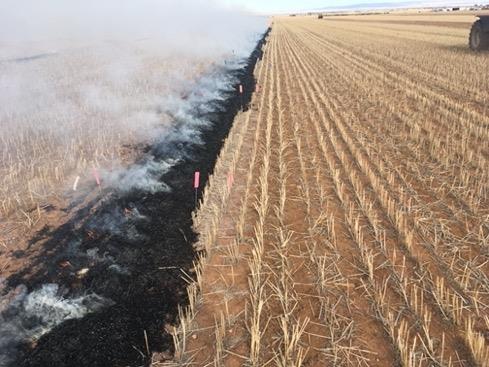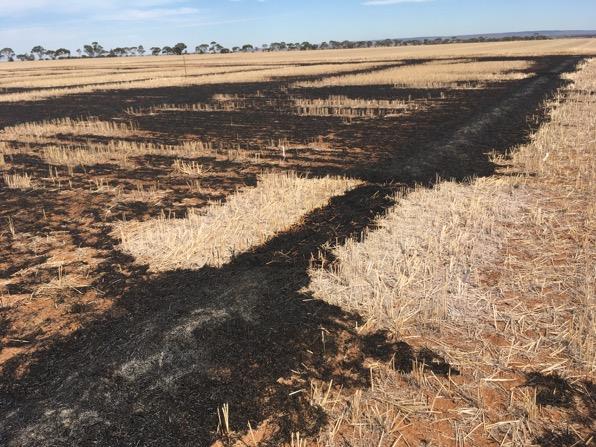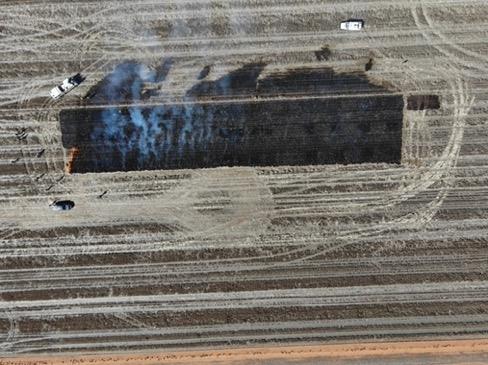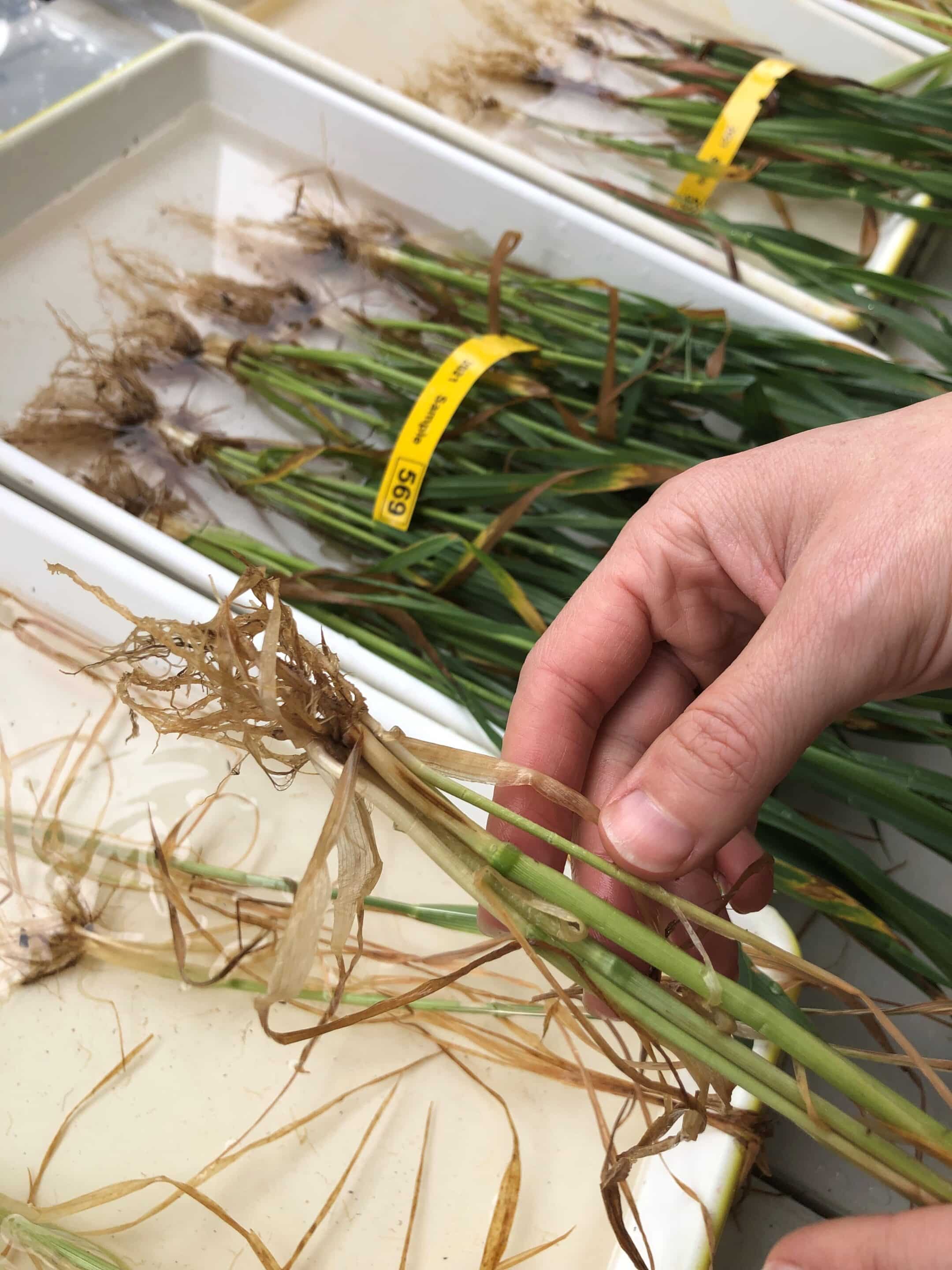START
FINISH
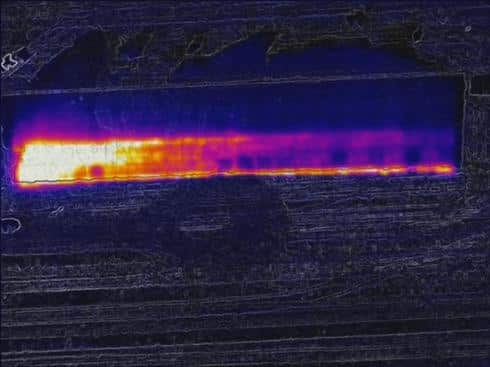
Summary
The project found through two on-farm burning trials that while pre-emptive flame retardants didn’t prevent a significant fire front passing, they did help decrease the transmission rate and heat intensity of the fire, resulting in less combustion of stubble in the paddock. Flame retardants applied along the edge of windows that were subsequently burnt showed control of lesser fires and ember attack may be achieved.
Background
Retaining stubble is one of the most important components of a sustainable farming system. However, stubble is also a fire risk in southern Australia over the summer.
A variety of pre-emptive flame-retardants that can be applied weeks or months in advance of a fire are coming onto the market. This project sought to understand whether these products could be effective enough to be incorporated into a farm fire management plan.
Research Aims
The core objective of the project was to evaluate how a new flame retardant could be incorporated into a farm’s fire management plan.
In The Field
Two trial sites were established – at Blyth with windrow burning and preliminary ember attack evaluation; and at Balaklava to test the ability of two new flame retardants to control a significant fire front.
At Blyth, for the windrow burning, a 30cm sideband of Phoscheck Fortify was applied along both edges of a 65m wheat windrow at two rates – 0.41L/ha and 0.82L/ha. Each treatment was applied for 5m and replicated three times on the upwind and downwind sides of the windrow. Each treatment was separated by an untreated 5m section.
To evaluate ember attack suppression, the two rates of Phoscheck were applied over the top of a windrow in a 3m x 3m plot. A flame was applied to the windrow using a diesel applicator fixed to a tractor.
At Balaklava, the fire front control trial included two new pre-emptive flame-retardant products, Phoscheck Fortify® – ammonium polyphosphate type – and Repella – organic potassium type. Both were applied at three different rates and at three different timings (1 day prior to burn, 1 month prior, 2 months prior). Each treatment was applied to a 2m x 2m plot and nil treatments were incorporated into the design, with each plot replicated three times.
Results
At Blyth, the windrow burn showed the capacity of the flame retardant to inhibit the spread of lesser fires away from windrows. With the ember attack plots, the flame retardants suppressed ignition at the highest rate of 0.82L/m2, while at 0.41L/m2, there was some suppression. Untreated windrows were burnt to ash.
At Balaklava, the pre-emptive flame retardants did not prevent the passage of a significant fire front. The burn was monitored using infrared imaging and, following the burn, each plot was scored for the retention of straw, char and ash.
Infrared drone imagery showed distinct plots that were cooler than untreated areas, however the product did not prevent fire transmission. The amount of combusted material between untreated plots and plots with higher application rates of flame retardant differed, with more soil cover left in higher application plots.
While they did not prevent the significant fire front, the flame retardants decreased the transmission rate of the fire in proportion with the rate applied. The heat intensity radiating from the fire was relative to the rate applied.
The research also showed the reliability of the products’ residual capacity to be retained over time.
Project Participants
South Australian No-till Farmers Association (SANTFA): Greg Butler and Andrew Bird
Farmers: Maurice Weich and Callum March
SA Department of Environment and Water: Fire Control Unit
The Problem
To determine the effectiveness of pre-emptive flame retardants to be incorporated into a farm’s fire management plan.
The research
Pre-emptive flame retardants didn’t prevent the passage of a significant fire front but did show other benefits to be explored further.
More information
Value for Growers
There is potential for the flame retardants to be used on-farm if consideration is given to application rates and limitations.
Significant fire fronts: Pre-emptive flame retardants do not prevent the passage of a significant fire front. They do however:
- decrease the transmission rate of the fire
- reduce the heat intensity radiating from the fire
- result in less combustion
- leave more soil cover relative to untreated areas.
Lesser fires: Pre-emptive flame retardants can inhibit lesser fires from spreading and may be useful when windrow burning over areas that are sensitive to drift, such as sandy rises.
Ember Attack: Pre-emptive flame retardants may inhibit ember attack from taking hold.
Subsequent research by SANTFA, funded by the Australian Government National Landcare Program, found a clear difference in the intensity and transmission rate of the fire in the ember attack that correlated strongly to the applied rate of flame retardants.
At this stage, the commercial cost and availability of these emerging products is not fully understood. However, the active ingredients are likely to be experiencing supply chain and price volatility similar to fertilisers, making these products relatively expensive to use over large areas. As a result, the most likely use in broadacre systems is not for whole of paddock application.
Latest Research Projects

